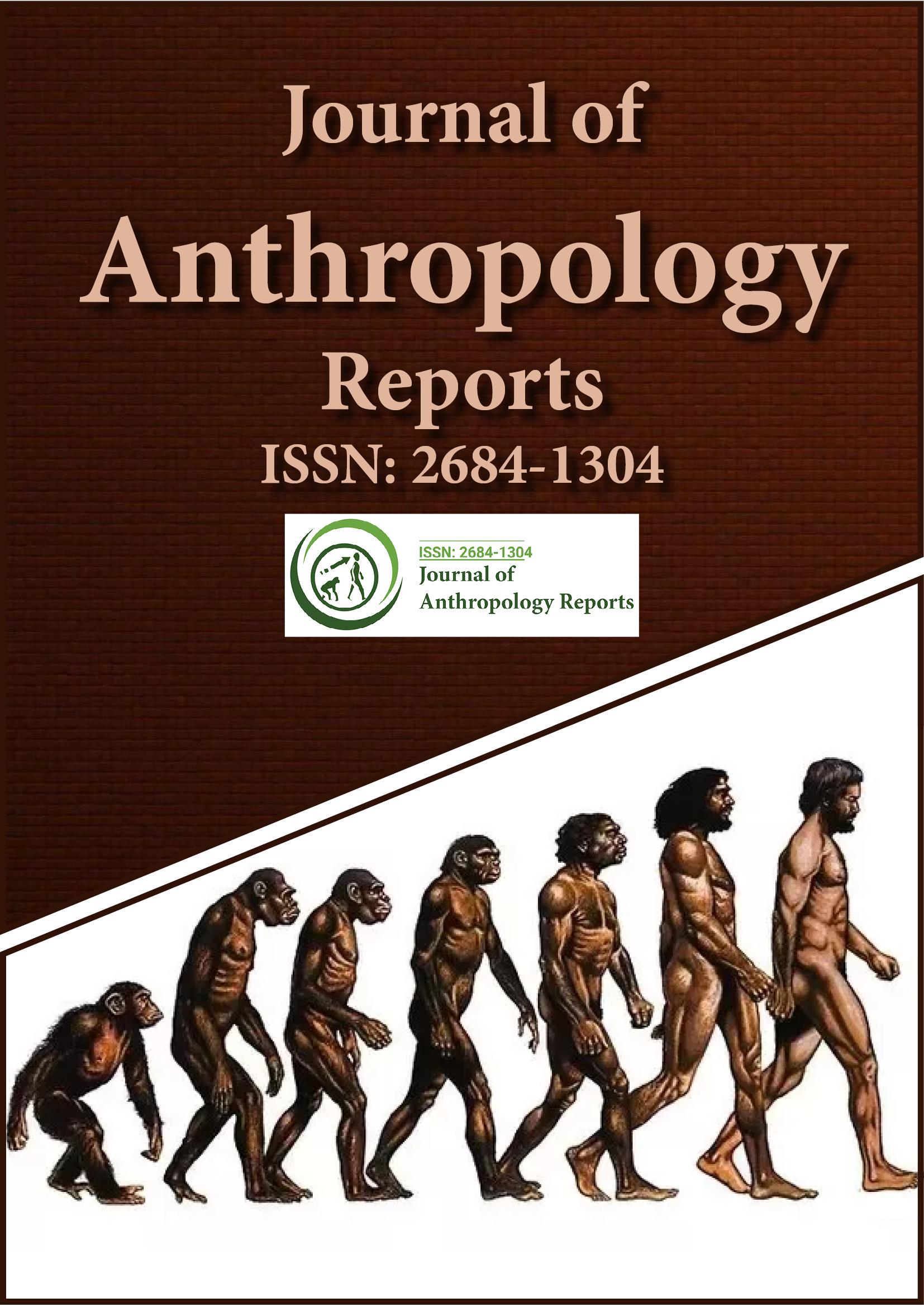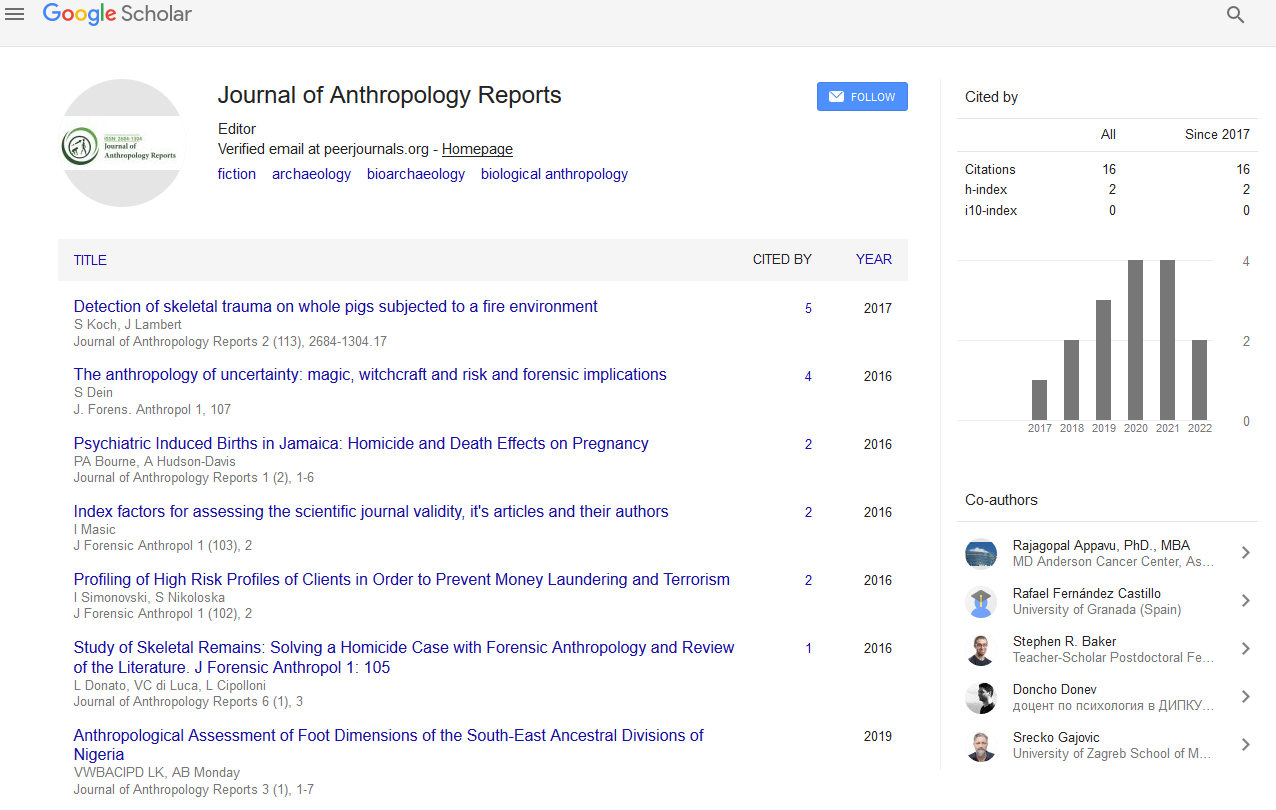Indexed In
- RefSeek
- Hamdard University
- EBSCO A-Z
Useful Links
Share This Page
Journal Flyer

Open Access Journals
- Agri and Aquaculture
- Biochemistry
- Bioinformatics & Systems Biology
- Business & Management
- Chemistry
- Clinical Sciences
- Engineering
- Food & Nutrition
- General Science
- Genetics & Molecular Biology
- Immunology & Microbiology
- Medical Sciences
- Neuroscience & Psychology
- Nursing & Health Care
- Pharmaceutical Sciences
Short Communication - (2022) Volume 5, Issue 6
The Significance of Archaeology in Evolutionary History
Jing Yang*Received: 07-Nov-2022, Manuscript No. JFA-22-18981; Editor assigned: 09-Nov-2022, Pre QC No. JFA-22-18981 (PQ); Reviewed: 25-Nov-2022, QC No. JFA-22-18981; Revised: 01-Dec-2022, Manuscript No. JFA-22-18981 (R); Published: 08-Dec-2022, DOI: 10.35248/2684-1304.22.5.141
Description
A branch of anthropological, which is the research of people, particularly the present and historical variations in human biology and behavior, is archaeology. Archaeology is more specifically the reconstructing of ancient behavior based on the artifacts that people left behind. Archaeology contributes significantly to our knowledge of the evolutionary development of Homo sapiens when linked with the study of the physiological changes which the human ancestry has undergone over the past several million years. Archaeologists utilize artifacts and geographic elements to learn about how people can live in specific times and places. They are curious about these people's daily activities, political beliefs, interpersonal relationships and core values. Sometimes, the only hints about a prehistoric group or civilization come from artifacts and features. We cannot read about prehistoric civilizations since they did not leave written records behind. Examining both artifacts, which are nonportable objects like structures or fireplaces and characteristics, which are portable objects like baskets or hammers, is a component of the study of cultural artifacts [1].
Related hints, which are frequently only discovered through careful excavation, are equally crucial to the archaeologist. In order to learn more about how past cultures used Stonehenge, archaeologists examining the structure lack old writings. They rely on the massive stones themselves, how they are positioned and how the location changed over time. In carefully monitored trials, bones have been fed to wolves and other mammals in prison and the wild. This has allowed archaeologists to differentiate between the imprints left by such and other creatures from all those left by humans. Some of the affluent explorers, explorers and merchants of this era also worked as archaeologists. They frequently came from West European colonial powers that were located elsewhere than where they dug. These unskillful archaeologists frequently showed genuine passion for the societies and objects they investigated. However, colonialism and cultural appropriation are also connected to their work [2].
They appropriated religious items and human remains from their traditional and historical sites while making money off of other civilizations' traditions. Early archaeological sites' fossils also reveal changes in the kinds of food hominines consumed and the distances they travelled. Early hominines probably infrequently got meat and, whenever they did, likely ate it close to the scene of the kill since they were frequently outcompeted by carnivores. However, by 50,000 years ago and perhaps even earlier, hominines were hunting a wide variety of animals and bringing home the best-tasting meat or nutritional components. Increasingly varied game meat and selection of nutrient-dense foods may indicate better hunting and have at least two additional significant effects. Archaeology eventually developed into a discipline that was more organized. Scientists began to record and remove artifacts using established procedures, standard weights and measurements and other techniques. They needed thorough sketches and draughts of both the whole excavation site and the individual components [3]. In an effort to create a cohesive understanding of the past, archaeologists started collaborating with classicists, archaeologists and linguists. When examining hominine diets, archaeologists frequently concentrate on skeletons, flesh and hunting not because these things accurately reflect what hominines consumed or how they passed their time, as has been suggested but rather because bones last longer than other types of food. Ethno archaeologists research how people currently utilize and arrange artifacts. They make use of this information to comprehend historical tool usage. Archaeologists could still learn about how the ancient San sought and slaughtered animals and collected native plants by examining the present San's tools. Paleoanthropology, the contributions to the science of human evolution, includes archaeology as a fundamental component [4].
In order for other theories that focus on biological change to be effective, archaeology must provide a long-term perspective on human behavioral change. The human fossil record is not nearly as extensive as the archaeological record. Applying radiocarbon dating to educate on atoms in chemistry or physics, for example, is one way that archaeology may be a useful teaching tool for more abstract concepts. Additionally, changing climate is a hot concern right now. Archaeologists frequently work to understand how ancient human societies adjusted to climatic change, which helps us understand how humans interact with the world today. Because archaeological research is based on physical items and data, it has the potential to instruct students about how science works in general. Additionally, it is a great technique to encourage cultural knowledge and sensitivity. It may also be utilized to educate critical thinking abilities, problem-solving skills and citizenship. Examining archaeological artifacts is frequently the only method to start understanding how people lived thousands of years ago for prehistoric cultures [5].
References
- Adler D, BarOz G, BelferCohen A, BarYosef O. Ahead of the game: Middle and Upper Palaeolithic hunting behaviors in the southern Caucasus. Curr. Anthropol. 2006; 47(1):89-118.
- Aiello LC, Wheeler P. The expensive-tissue hypothesis: the brain and the digestive system in human and primate evolution. Curr Anthropol.1995; 36:199–221.
- Anikovich MV, Sinitsyn AA, Hoffecker JF, Holliday VT, Popov VV, Lisitsyn SN, et al. Early Upper Paleolithic in Eastern Europe and implications for the dispersal of modern humans. sci. 2007; 315(5809):223-226.[ Google Scholar]
- Baddeley A,Chang YM, Song Y, Turner R. Nonparametric estimation of the dependence of a spatial point process on spatial covariates.Stat Interface. 2012; 5(2):221-236
- Jedwab R, Vollrath D.Urbanization without growth in historical perspective. Explor. Econ. Hist.2015; 58:1-21.
Citation: Yang J (2022) The Significance of Archaeology in Evolutionary History. J Anthropol Rep. 5:141.
Copyright: © 2022 Yang J. This is an open-access article distributed under the terms of the Creative Commons Attribution License, which permits unrestricted use, distribution, and reproduction in any medium, provided the original author and source are credited.

